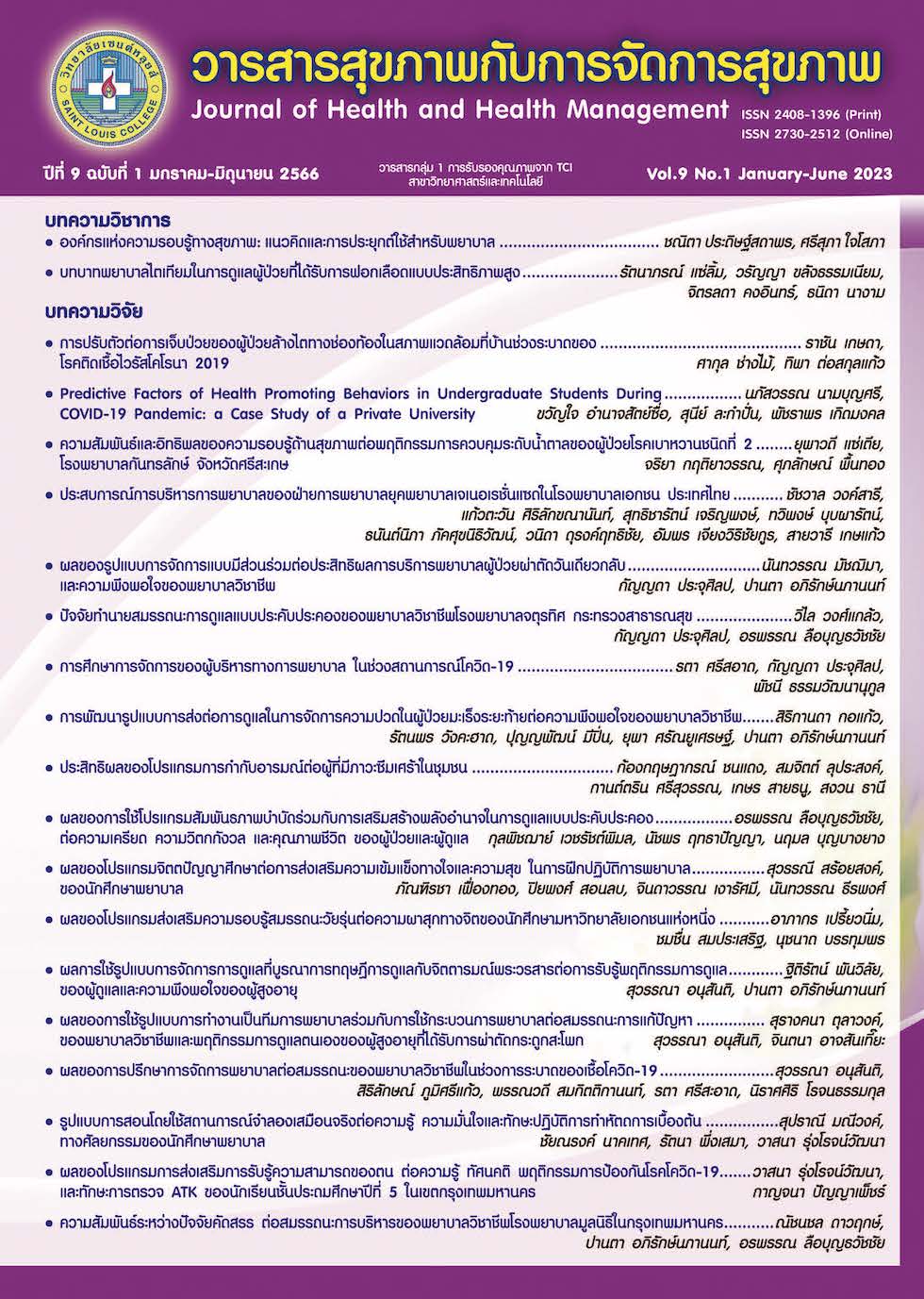Nursing care of Online Hemodiafiltration
Keywords:
role, hemodialysis nurse, Online HemodiafiltrationAbstract
Online Hemodiafiltration : OL- HDF is the development of treatment with hemodialysis to be more effective by increasing the ability to remove wastes that are large molecules accumulated in the body better than conventional Hemodialysis methods by relying on the process of Convection and Diffusion, patients with long-term conventional hemodialysis will have large molecular wastes accumulated in the body for a long time, causing the body to be sick. And if eliminated in such a way will help make the patient healthy and reduce the death rate from cardiovascular disease. Including having a long life and a better quality of life High-efficiency hemodialysis requires only a dialysis machine capable of high-efficiency dialysis. A large pore blood filter must be used and Ultrapure Water System. Therefore, the role of a hemodialysis nurse as a caregiver for high-efficiency dialysis patients must be knowledgeable and skilled in using a hemodialysis machine capable of high-efficiency dialysis. Monitor the infection prevention of the hemodialysis system, High-quality purified water system to meet the standards of the Thai Kidney Association Infection is monitored by the use of sizeable perforated blood filters. Easy monitoring of clogged blood filters during hemodialysis and resolution of complications during hemodialysis to provide patients with the safety and efficiency of hemodialysis. In addition, hemodialysis nurses must educate their patients on nutrition due to a more significant loss of protein and vitamins than in conventional hemodialysis.
References
ขจร ตีรณธนากุล. (2562). Hemodiafiltration. กรุงเทพ: เท็กซ์ แอนด์ เจอร์นัล พับลิเคชั่น จำกัด.
ขจร ตีรณธนากุล. (2566). เทคนิคใหม่ของการฟอกเลือดด้วยวิธีออนไลน์ฮีโมไดอะฟิวเตชัน. กรุงเทพฯ: พี.เอ.ลีฟวิ่ง จำกัด.
ธีรศักดิ์ ตั้งวงษ์เลิศ. (2565). Adequacy of Hemodialysis. กรุงเทพฯ: นำอักษรการพิมพ์.
ปรมัตถ์ ธิมาไชย. (2565). Hemodiafiltration and Hemofiltration. กรุงเทพฯ: นำอักษรการพิมพ์.
วิศิษฎ์ แก้วพุด.(2565). Vascular access for Hemodialysis. กรุงเทพฯ: นำอักษรการพิมพ์.
ศิกวัส ธนาวิรัตนานิจ. (2565). โรคภาวะขากระตุกขณะหลับ. สืบค้นจาก https://www.thansettakij.com/lifestyle/526502
สมาคมโรคไตแห่งประเทศไทย. (2565). ข้อแนะนำเวชปฏิบัติการฟอกเลือดด้วยเครื่องไตเทียม. กรุงเทพฯ: เท็กซ์ แอนด์ เจอร์นัล พับลิเคชั่น จำกัด.
สมาคมโรคไตแห่งประเทศไทย. (2564). แนวทางปฏิบัติเรื่อง การเตรียมน้ำบริสุทธิ์เพื่อการฟอกเลือดด้วยเครื่องไตเทียม. กรุงเทพฯ: เท็กซ์ แอนด์ เจอร์นัล พับลิเคชั่น จำกัด.
สุรเชษฐ์ วงษ์นิ่ม. (2562). Long-term complications of hemodialysis. กรุงเทพ: เท็กซ์ แอนด์ เจอร์นัล พับลิเคชั่น จำกัด.
Canaud, B., Bosc, J. Y., Leray‐Moragues, H., Stec, F., Argiles, A., Leblanc, M., & Mion, C. (2000). On‐line haemodiafiltration. Safety and efficacy in long‐term clinical practice. Nephrology Dialysis Transplantation, 15(1), 60-67.
Canaud, B., & Davenport, A. (2022). Prescription of online hemodiafiltration (ol‐HDF). In Seminars in Dialysis, 35(5), 413-419
Kikuchi, K., Hamano, T., Wada, A., Nakai, S., & Masakane, I. (2019). Predilution online hemodiafiltration is associated with improved survival compared with hemodialysis. Kidney international, 95(4), 929–938.
Kooman, J., Basci, A., Pizzarelli, F., Canaud, B., Haage, P., Fouque, D., ... & Vanholder, R. (2007). EBPG guideline on haemodynamic instability. Nephrology Dialysis Transplantation, 22(2), 22-44.
Macías, N., Vega, A., Abad, S., Santos, A., Cedeño, S., Linares, T., ... & López‐Gómez, J. M. (2017). Is high‐volume online hemodiafiltration associated with malnutrition?. Therapeutic Apheresis and Dialysis, 21(4), 361-369.
Panichi, V., Rosati, A., Bigazzi, R., Paoletti, S., Mantuano, E., Beati, S., ... & RISCAVID Study Group. (2011). Anaemia and resistance to erythropoiesis-stimulating agents as prognostic factors in haemodialysis patients: results from the RISCAVID study. Nephrology Dialysis Transplantation, 26(8), 2641-2648.
Penne, E. L., Visser, L., Van Den Dorpel, M. A., Van Der Weerd, N. C., Mazairac, A. H., Van Jaarsveld, B. C., ... & Grooteman, M. P. (2009). Microbiological quality and quality control of purified water and ultrapure dialysis fluids for online hemodiafiltration in routine clinical practice. Kidney international, 76(6), 665-672.
Peters, S. A., Bots, M. L., Canaud, B., Davenport, A., Grooteman, M. P., Kircelli, F., ... & Blankestijn, P. J. (2016). HDF Pooling Project Investigators: Haemodiafiltration and mortality in end-stage kidney disease patients: A pooled individual participant data analysis from four randomized controlled trials. Nephrol Dial Transplant, 31(6), 978-984.
Sarafidis, P. A. (2017). Online Hemodiafiltration Improves Outcomes in Incident Patients with End-Stage Renal Disease: Another Brick in the Wall?. American Journal of Nephrology, 46(4), 285-287.
Downloads
Published
How to Cite
Issue
Section
License
Copyright (c) 2023 Journal of health and health management

This work is licensed under a Creative Commons Attribution-NonCommercial-NoDerivatives 4.0 International License.




